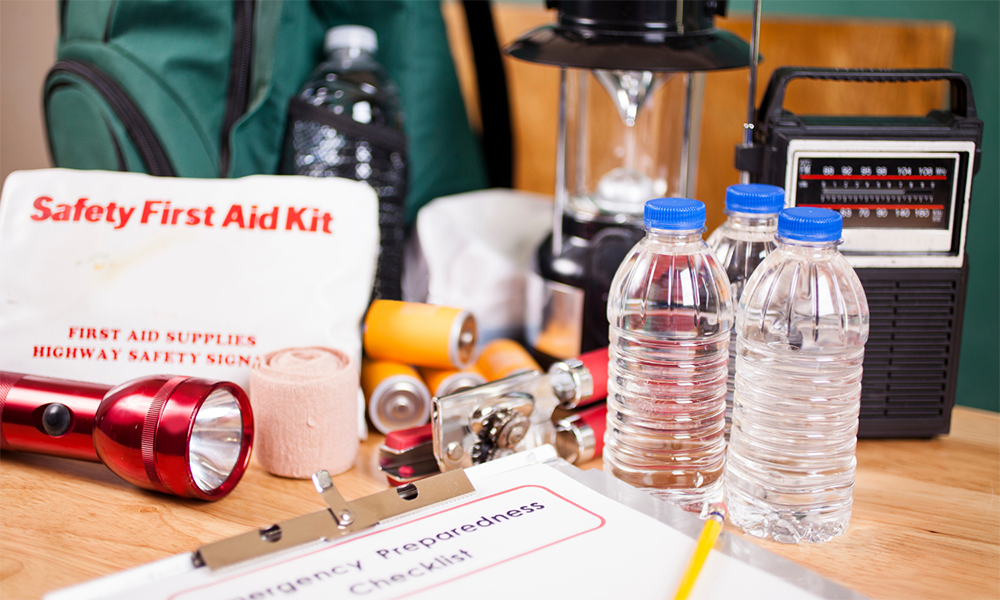The best way for every individual to help during an emergency situation in a community is first to prepare themselves. With the arrival of a tornado, wildfire, and flood season, it is time to plan ahead so property and precious lives can be protected. State and national government agencies, along with Colorado State University Extension, have extensive resources for all types of emergency situations. Here are some basic guidelines to help your family prepare for basic needs such as food and water.

Preparing Food and Water for Emergency
Consider these tips when preparing your shelf-stable food supply:
- Store food you like and normally eat.
- Every 6 to 12 months rotate and use food and water.
- Consider small can sizes that provide just the number of servings you will consume at one time. If your power is off, refrigerating leftovers is not an option.
- Keep disposable eating utensils and a manual can opener on hand.
- Do not include instant foods if you don’t have an alternative way to boil water.
- To avoid insect and rodent damage store food packaged in cardboard boxes, thin plastic, or paper in metal, glass, or rigid plastic containers.
- Choose shelf-stable foods that do not require a refrigerator or freezer for storage. Once opened or prepared, many foods no longer are shelf-stable.
What types of food should you store?
A three-day supply of emergency food for one adult includes:
- Grains: 18-33 servings
- Fruit: 12-16 servings
- Vegetables: 9-15 servings
- 6-9 servings from the Meat, Poultry, Fish, Dry Beans, Eggs, Nuts Group
- Dairy: 6-9 servings
Choose My Plate food and water recommendations
Grains:
- Bread
- Cereal
- Rice
- Pasta
Easy to store Vegetables:
- Canned vegetables
- Canned soups
- Instant vegetable
- Potato soups
- Canned or bottled vegetable juice
Dairy and Calcium Rich Sources
- Canned evaporated milk
- Canned pudding
- Processed cheese
- Snack pudding cups
- Dry milk
- Shelf-stable milk or alternative milks like rice milk or soy milk
Meat and Proteins
- Canned or pouched tuna
- Sardines
- Salmon
- Chicken
- Other canned meats,
- Canned soups with meat
- Canned beans
- Peanut butter and nuts
- Commercially prepared jerky
Water Storage
Plan and store one gallon of water per day, per person for drinking, cooking, and personal hygiene. Food-grade plastic or glass containers or any container that previously held food or beverages and are cleaned properly are suitable for water storage. Label each of the containers “drinking water” with the current date.
Emergency Supplies
Many of these items you already have around the house. Gather and organize them into a duffle bag, small suitcase, or plastic tote, and label it. Suggestions for an emergency supply kit include:
- Personal first-aid kit
- Battery-powered flashlight with extra batteries
- Battery-powered radio with extra batteries
- Personal medication record
- Extra Prescription medications or a list of all prescriptions
- Hygienic items (toothbrush/hand sanitizer/female-hygiene)
- Extra clothing
- Blankets
- Rain poncho
- 12-hour light sticks
- Whistle to alert rescue parties
- Face mask (to avoid inhalation of dangerous bacteria or smoke/debris)
Online Resources
Author
Tracy Trumper, Family, and Consumer Extension Agent Colorado State University Extension, Phillips County
Disclaimer
Colorado State University, U.S. Department of Agriculture, and Colorado counties cooperating. CSU Extension programs are available to all without discrimination. No endorsement of products mentioned is intended nor is criticism implied of products not mentioned.

